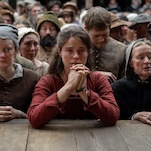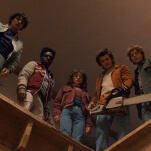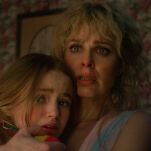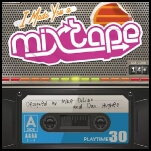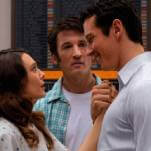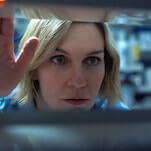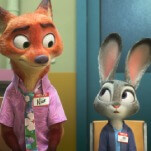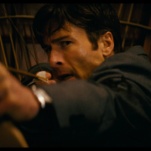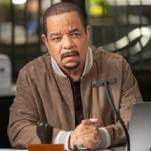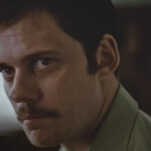Richter wrote the score for Hamnet, but he returned to his acclaimed back catalog for its finale, borrowing “On The Nature Of Daylight” from his 2004 release The Blue Notebooks. The album, which The Guardian heralded as one of the greatest pieces of classical music from the 21st century, was written as what Richter described as “a protest album about Iraq, a meditation on violence—both the violence that I had personally experienced around me as a child and the violence of war, at the utter futility of so much armed conflict.” Its second track quickly became one of Richter’s signature works. It’s devastating in its subtlety and instantly affecting. As writer and composer Zoe Sones explained in Indie Tips, “Max Richter speaks of how he wants his music to be a listening space to think. The simplicity behind the building blocks of this composition creates a space that isn’t too invasive to our subconscious. The piece moves along.” You don’t need to be a classical music expert to respond viscerally to Richter’s work. “On The Nature Of Daylight” so acutely captures a sense of both loss and love that it’s no wonder filmmakers keep using it over and over and over.
It only took a couple of years following The Blue Notebooks‘ release for Hollywood to become inspired. Martin Scorsese used it in Shutter Island, his surreal noir about a twisty missing person case in a psychiatric facility. The ensemble drama Disconnect included it on their soundtrack for a story about modern technology’s ability to strip humans of real bonding experiences. It’s so prominently (and crushingly) used in Denis Villeneuve’s Arrival that it led to the film’s actual composer, Jóhann Jóhannsson, being deemed ineligible for a Best Score Oscar. It makes sense, because the track is the musical glue of a sci-fi story about the inevitability of grief. After Shutter Island brought it to audiences, it was Arrival that cemented the cultural status of “On The Nature Of Daylight.” This was the music for making audiences cry, with hope as well as sadness.
But Hamnet truly feels like the last time we can get away with using this Richter piece in a narrative. Zhao and Richter use it so sublimely in this climactic outpouring of grief and creativity, a well-earned moment of catharsis through art, that they earn the right to repeat what is now cliché. It is but one piece of music in a film full of gorgeous compositions by an artist with a cohesive vision in mind. The conclusion of the film invites us to feel the closure that Agnes is finally experiencing, with Richter’s familiar finale complementing the excellent performance of Jessie Buckley rather than doing the legwork in place of her. Zhao could have used silence and still made this moment work; after all, she got the tears flowing earlier in the movie with Hamnet’s death, and that is done with no score.
Directors return to familiar musical beats for a reason. Tropes get worn out because they help emphasize the universality of our emotions. Think of the close-up during that big monologue, the third-act race through the airport, and the training montage scored by an inspirational bop. A bit like what you get from casting a movie star, it’s not unheard of for those coordinating a film’s music to rely on the audience’s awareness of its prior uses to make that big moment land. Vietnam War movies use “Fortunate Son” by Creedence Clearwater Revival because of Forrest Gump (itself riffing on Apocalypse Now), but also because it so strongly exemplifies a particular blend of nostalgia and struggle.
But “Fortunate Son,” like a select few other tracks, are now all but prohibited for use as needle drops. You can’t use Queen’s “We Are The Champions” or Marvin Gaye’s “Let’s Get It On,” regardless of their appropriateness for the scene, because they’re so overused that nothing can overcome their tedious familiarity. Now they just play like a joke. The same goes for many a tearjerking favorite, like “Hoppípolla” by Sigur Rós. It’s one of the greats of 2000s post-rock, but it’s now been reduced to lazy shorthand for cheaply earned pathos. It’s practically a “Please Sob” sign flashing before a live studio audience. “On The Nature Of Daylight” is at risk of befalling this fate, not simply from overuse, but because of how similarly it’s always rolled out. If it becomes the go-to “cry but fear not” soundtrack, it will lose its power.
Pre-Hamnet, it was already becoming the de facto cheat-code cry music of film and TV, and listeners were lamenting its overuse as early as 2020. Now we’re in an era of “On The Nature Of Daylight” overkill, where it becomes cheap compensation for half-assed storytelling. It’s already been poorly used in shows like 9-1-1 and Castle Rock, providing that cheap sentiment where the narrative cannot compensate. It’s been deployed in media as varied as Willem Dafoe’s Disney dog movie Togo and an episode of the long-running British soap opera EastEnders. The latter is especially odd given the disconnect between the sturdy kitchen-sink drama and the delicacy of Richter’s compositions. Even that show used it the same way everyone else did: to score a moment blending tragedy with hope (albeit on a sinking river boat). Last year, “On The Nature Of Daylight” seemed like it may have reached its saturation point with The Last Of Us episode “Long, Long Time,” which told the love story between Bill (Nick Offerman) and Frank (Murray Bartlett). Over the course of a decade, and with the backdrop of an all-consuming apocalypse, this pair live a good life together, and they choose to end it on their terms. Death comes for us all, but life wins.
Because “On The Nature Of Daylight” works best when overwhelming loss is balanced by hope, you’re invited to cry with happiness as much as with desolation. Bill and Frank choose to die together rather than let the bleakness of a dystopian world win. In Arrival, Louise embraces the pain she knows is to come in her future because it is a worthy price to pay for the joy that will accompany it. The climactic performance that brings together a family and a community in Hamnet is a salve that heals the Shakespeares and unites them in love. This canny blend of music, source material, technical craft, and performance means that Hamnet has now thoroughly claimed “On The Nature Of Daylight.” Any other piece of media trying to use it in the following years will feel not just rote, but like obvious thievery. That music now belongs to Hamnet, and it should for the foreseeable future.
“On The Nature Of Daylight” will surely become as familiar a piece of classical music to film and TV audiences as the 1812 Overture or “Also Sprach Zarathustra.” It has proven its effectiveness for scoring moments of grief and hope, for providing the sonic foundation of weepy climaxes that still make us smile with optimism for the world. But let’s admit that it’s peaked. Let’s take Hamnet as a sign to stop turning such powerful music into an easy way out for quick emotional manipulation. Even the most earnest uses of “On The Nature Of Daylight” post-Hamnet will pale in comparison to its most carefully artful use. Before this film, it was already in danger of becoming a thoughtlessly employed “cry here” signal. After Hamnet, it will become even more defined as the ultimate sob-inducing track, and filmmakers everywhere should note (and avoid) its looming status as a cliché.


